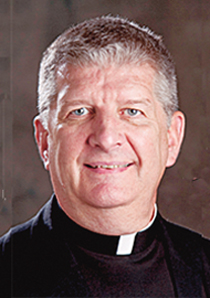
Faith
Simple or solemn, alone or in a group, a blessing is, in any form, a reminder first about God's creative love.

O’Grady
Most priests, and probably a good number of deacons, have heard that request made, and many of you good readers have probably made such a simple request. And the blessing was probably gladly given, perhaps accompanied with a sprinkling of holy water.
This column is about the blessing of things. The "Book of Blessings" has pages of blessings for all kinds of things.
Forty-eight chapters in the book have prayers for the blessings of things. A scan of the table of contents is interesting: New Home, New Seminary, New School, New Library, New Hospital, New Shop, Athletic Field, Tools, Equipment, Fields. Then items used for religious purposes: your medal, your rosary, New Baptistery, New Lectern, New Tabernacle, New Confessional, Bells, Organ, Chalice and Paten, Holy Water, Stations of the Cross, Cemetery.
Then things rated to liturgical seasons: Advent Wreath, Creche, Christmas Tree, and Ashes.
And yes, there are blessings for your pets.
The book provides many options for the blessings to occur. They may be within or outside of Mass of a Liturgy of the Word or at Vespers. The blessings may be with a community, a few folks, or just one. The format of the blessing might be a shorter, brief version or a lengthier one more appropriate for a group seeking blessings of things. A good example of this last type is the widely celebrated blessing of pets on the Memorial of St. Francis of Assisi.
Perhaps a most familiar blessing is the grace before meals. The book provides some of the more traditional and well-known as well as some newer ones.
Two more solemn blessings are not in the "Book of Blessings" but are blessings of things.
Mass of Chrism
First, the blessing of oils and the consecration of chrism. This blessing is celebrated in the cathedral church either on Holy Thursday morning or on a day prior to Holy Thursday.
The Mass is commonly called the Chrism Mass, and it is the chance of the bishop to gather with the priests, deacons, and faithful of the diocese for this very solemn blessing. This assembly of the diocesan family brings the family together for an annual reunion and celebration of their common call to priestly life -- baptismal or ordained. It is the particular celebration of the priesthood of our ordained priests -- both diocesan or secular and regular or religious.
During the Mass, the oils used throughout the diocese for the celebration of baptism (oil of the catechumens), anointing of the sick (oil of the sick) and the consecration of the sacred chrism used in baptisms, confirmations, ordinations of presbyters and bishops, and dedication of altars and churches are blessed. The chrism in both the Eastern and Western Churches has always held a special place in the lives of the churches. Especially in the Eastern Churches, chrism is honored as a special place dwelling of the Holy Spirit and is consecrated by the patriarch for his churches.
Crowning an Image of the Blessed Virgin
Another more solemn blessing that is often used in parishes in an adopted form during May processions is the Order for the Crowning of an Image of the Blessed Virgin Mary.
The more solemn form of this is a rite celebrated for an image, usually a statue of the Blessed Virgin, either with or without her Divine Son.
This ceremony, in its solemn form, is for images that are of particular and widespread devotion in a diocese. The celebrant, by tradition, is the diocesan bishop. He may designate another bishop or a priest to celebrate this.
Again, the crowning may be celebrated at a Mass, during a Liturgy of the Word, or during Vespers. Most often, it would be at a Mass, as this is unique and not to be repeated for this image. Similarly, the presence of the diocesan bishop as the celebrant underlines the importance to the diocese and to the whole church of this image and its accompanying devotions.
If the image is of the Blessed Virgin alone she is crowned, if the image includes the Lord Jesus, then he is crowned first, and then his mother.
An additional note is that if the image is of particular importance beyond the local church or diocese, it may be crowned either directly by the Roman Pontiff or by a bishop (usually a cardinal) whom he designates. Pope St. John Paul II, greatly noted for his devotion to the Holy Mother of God, celebrated crownings in many spots around the globe.
Parishes may adapt this blessing for an annual May Procession. Unlike the solemn crowning, the parish May Procession and Crowning is repeated annually.
Simple or solemn, alone or in a group, a blessing is, in any form, a reminder first about God's creative love. It always includes an element of praise for God's greatness, for his providing us with what we need for life, and to thank him for all he has done, is doing, and will do.
Blessed be God, forever.
Recent articles in the Faith & Family section
-
Did you know?Father Robert M. O'Grady
-
Sowing the Seeds of FaithMaureen Crowley Heil
-
Bread left overScott Hahn
-
Scripture Reflection for July 28, 2024, Seventeenth Sunday in Ordinary TimeJem Sullivan
-
What the universal call to holiness entailsDr. R. Jared Staudt





